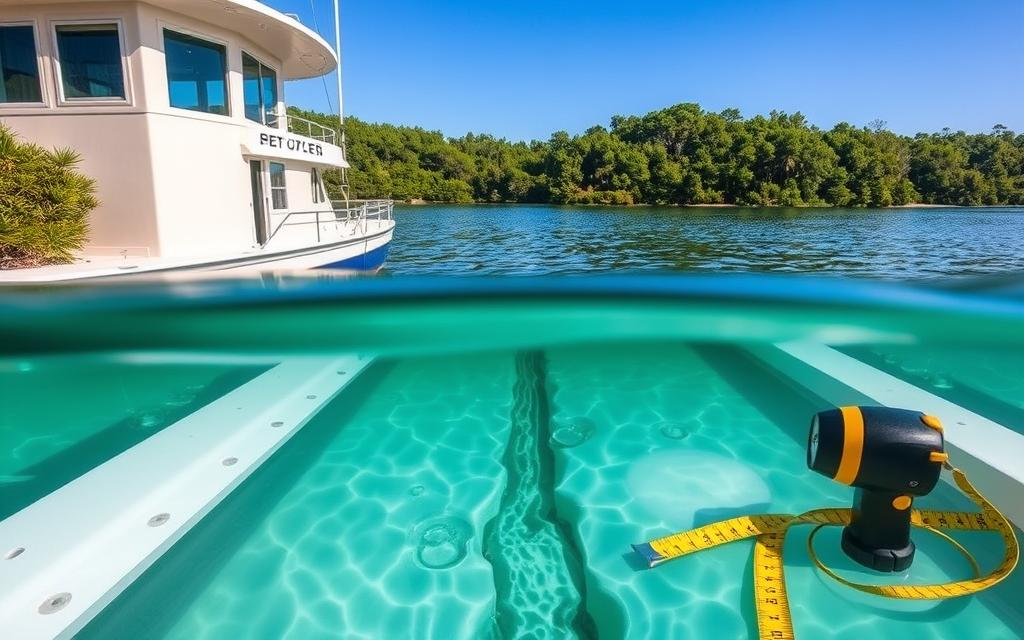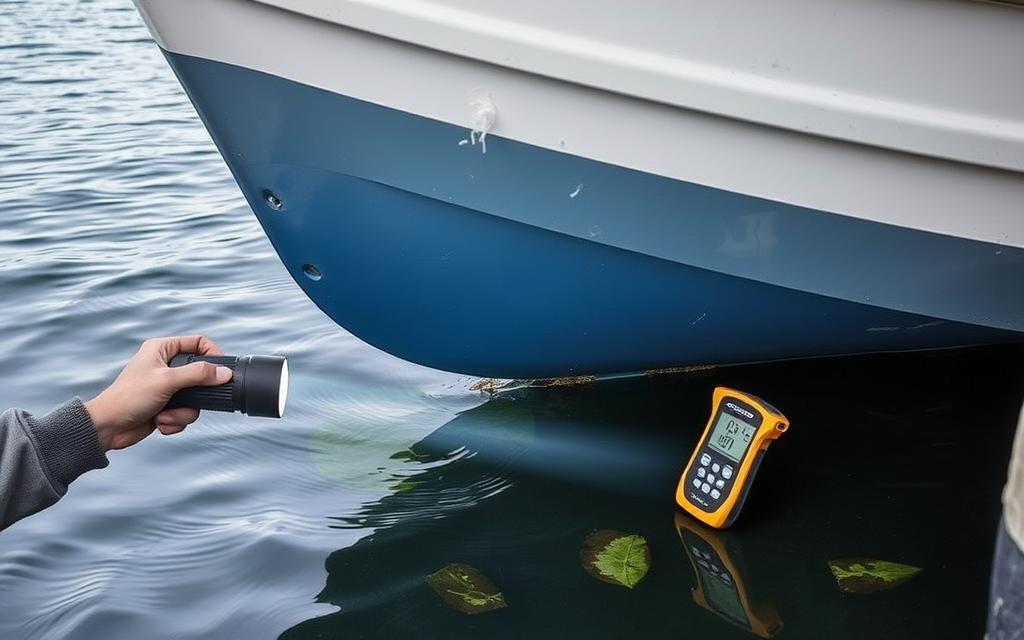Table of Contents
As a houseboat owner, keeping your floating home safe is key. Leaks can be dangerous, causing water damage and weakening your boat’s structure. This guide will show you how to find and fix leaks, helping you protect your investment.

Key Takeaways
- Regularly inspect your houseboat for signs of leaks to prevent water damage and structural issues.
- Understand the common sources of leaks, both above and below the waterline, as well as interior moisture points.
- Utilize the right tools and equipment, such as moisture meters and pressure testing devices, to accurately identify leak locations.
- Assess the hull’s integrity and monitor the condition of critical marine systems, including through-hull fittings and seacocks.
- Develop a preventive maintenance routine to minimize the risk of future leaks and ensure the long-term safety and performance of your houseboat.
Understanding Common Houseboat Leak Sources
Keeping your houseboat in top shape means spotting and fixing leaks early. From the top to the bottom, knowing where leaks can happen helps prevent big problems. This way, you avoid expensive fixes and water damage.
Above Waterline Vulnerabilities
The outside of your houseboat fights off water. Look for cracks, holes, or gaps in the sealant. These can let water in. Check windows, hatches, and other parts that might let moisture in.
Below Waterline Risk Areas
Leaks below the waterline are harder to find but serious. Check the hull, keel, and other parts under the water for damage. Regular hull integrity assessments and boat surveys keep these areas safe.
Interior Moisture Points
- Look for water signs inside, like damp walls or musty smells.
- Focus on plumbing, windows, and hatches, as they let moisture in.
- Use a moisture meter to find hidden watercraft troubleshooting issues early.
Knowing where leaks can start helps you find and fix them fast. This keeps your houseboat safe and in good shape for years.
Essential Tools and Equipment for Leak Detection
Keeping your houseboat in top shape is key, and spotting leaks is a big part of that. To do a good marine inspection and keep your watercraft safe, you need the right tools. These tools help with preventing leaks and keeping your houseboat in good condition.
A reliable moisture meter is a must-have for finding leaks. It lets you check the moisture in different materials, showing you where to look closer or fix things. Also, using pressure testing gear can find weak spots in the hull and other important parts. This helps you catch problems before they get worse.
- Moisture meters
- Pressure testing devices
- Visual inspection aids (magnifying glasses, flashlights, etc.)
- Sealants and caulking materials
- Repair kits for patching leaks
With these tools, you can do detailed marine inspections. This keeps your houseboat safe and lasts longer. Regular checks and quick fixes help keep your boat strong and avoid expensive problems later.
“The key to effective houseboat leak prevention is having the right tools and being proactive in your approach.”
SHORTCODE FOR NEWSLETTER:-
Having a good toolbox is important for finding and fixing leaks on your houseboat. By getting the right gear, you protect your investment and can enjoy the water without worry.
How to Check Your Houseboat for Leaks: Step-by-Step Process
Keeping your houseboat in great shape means you need to watch for leaks and check it often. By using a clear plan, you can spot and fix leaks early.
This keeps your houseboat safe and sound for years to come. We’ll show you how to check for leaks step by step, including how to look for them, use moisture meters, and test pressure.
Visual Inspection Techniques
Start by looking over your houseboat carefully. Check the hull, deck, and cabin outside. Look for cracks, color changes, or signs of dry rot that could let water in. Inside, check walls, floors, and ceilings for moisture or stains that might mean a leak.
Using Moisture Meters
Use a moisture meter to help your visual check. This tool scans surfaces to find moisture, even where you can’t see it. It helps you find the exact leak spot and guides your fix.
Pressure Testing Methods
For a detailed check, try a pressure test. Seal off parts like the hull or plumbing, then apply air or water pressure. Leaks show up as changes in pressure or escaping air or water. This method finds even tiny leaks, keeping your boat strong.
By mixing visual checks, moisture meter use, and pressure tests, you get a full leak check. This keeps your houseboat dry, comfy, and safe. Regular upkeep and early leak finding are key to a happy, leak-free houseboat life.
Hull Integrity Assessment Guide
Keeping your houseboat’s hull in good shape is key for safety and avoiding expensive damage from moisture. As a boat owner, it’s vital to check your vessel’s hull regularly. This means doing a detailed inspection.
Start by looking at the hull for cracks, blisters, or any wear. Focus on the parts below the waterline, as they’re more at risk of water damage. Use a moisture meter to find out if the hull has too much moisture, which could mean trouble.
- Look for signs of stress or wear, like crazing, delamination, or osmotic blistering.
- Check the keel, rudder, and other underwater parts for damage or wear.
- Make sure the through-hull fittings and seacocks are sealed well and work right.
If you think there’s a problem with the hull, get a marine surveyor to check it out. They can do tests like ultrasound scans or core sampling. This helps figure out the hull’s condition and find any repairs or strengthening needed.
“Maintaining the structural integrity of your houseboat’s hull is not just a safety concern, but also a critical factor in keeping your watercraft’s value and performance over time.”
By regularly checking your houseboat’s hull and fixing any problems fast, you keep the hull integrity. This reduces the chance of moisture damage and makes your marine inspection safer. Taking care of your boat this way can make it last longer and give you peace of mind while you’re out on the water.

Checking Plumbing and Marine Systems
Keeping your houseboat’s plumbing and marine systems in top shape is key. It stops leaks and keeps your boat safe and lasting longer. Regular checks on through-hull fittings, seacocks, and bilge pumps can spot problems early.
Through-Hull Fittings
Through-hull fittings let water in and out of your boat. They need regular checks for wear, corrosion, or damage. Look at the sealant and make sure the fitting is tight and watertight.
Seacock Inspection
Seacocks control water flow through the fittings. Make sure they open and close well and that gaskets are good. Also, check for leaks and keep them well-lubricated.
Bilge Pump Testing
- Test your boat’s bilge pumps often to make sure they work.
- Look for cracks, kinks, or blockages in the hoses.
- Make sure the pump is mounted right and electrical connections are good.
- Think about getting a stronger bilge pump if yours isn’t enough for your houseboat.
Being proactive with your vessel’s plumbing and marine systems can save you money. It also keeps your watercraft safe and in good shape.
Deck and Cabin Leak Detection
As a seasoned marine surveyor, I know how important it is to keep your houseboat safe from leaks. Leaks in the deck and cabin can be tricky to find. We’ll look at how to spot and fix these leaks in these key areas.
Spotting leaks in your houseboat’s deck and cabin needs a careful eye. Start by looking closely at windows, hatches, and other spots where water might get in. Watch for water damage, color changes, or mold and mildew. These signs can point to a leak.
Using a moisture meter is also a smart move. It helps find hidden moisture. Scan the cabin and deck surfaces to find where water is getting in. This helps you focus your leak search.
Pressure testing is another way to find leaks. It uses air pressure to find small breaches. This is great for finding leaks around seals and gaskets.

Keeping your houseboat’s deck and cabin in good shape is key to a safe and comfy life on the water. Using these methods can help protect your boat from leaks. This saves you from expensive fixes later.
While you can do some maintenance yourself, sometimes it’s best to get a pro’s help. A marine surveyor can offer valuable advice. They help keep your houseboat in top shape, both above and below the waterline.
Professional Inspection vs. DIY Methods
As a houseboat owner, you can choose between doing a DIY leak check or hiring a marine surveyor. Each option has its own benefits and things to consider.
When to Call a Marine Surveyor
DIY checks can save money, but there are times when a pro is needed. If you’re not sure about the waterproof inspection or have a tricky marine vessel repair, a marine surveyor is a great help. They offer valuable insights and guidance.
Cost Considerations
The cost of a marine surveyor varies based on your houseboat ownership. A basic waterproof inspection might cost $300 to $500. More detailed surveys can be over $1,000. Though it’s a big investment, the peace of mind and expertise from a pro are worth it, for complex marine plumbing or boat plumbing issues.
| Inspection Type | Average Cost | Expertise Level | Recommended For |
|---|---|---|---|
| DIY Inspection | $0 – $100 | Basic | Routine maintenance, basic leak detection |
| Professional Marine Survey | $300 – $1,000+ | Advanced | Complex issues, thorough hull and system check |
Choosing between DIY and a professional marine survey depends on your houseboat ownership experience and comfort with waterproof inspection. Weighing the costs and benefits helps you decide what’s best for your houseboat’s health.
Preventive Maintenance Tips for Leak Prevention
Keeping your houseboat’s hull and seals in good shape is key to avoiding expensive leaks. Regular bilge monitoring, boat safety checks, and marine maintenance can help your boat last longer and stay safe. Here are some important tips to keep your houseboat in great shape:
- Check and seal all through-hull fittings, seacocks, and other spots where water might get in. Use top-notch marine sealants for a strong, lasting seal.
- Do houseboat inspections twice a year to look for cracks, holes, or wear on the hull and cabin. Fix any problems right away to stop them from getting worse.
- Make sure your bilge pump works well by testing it often. This ensures it can clear out water in the bilge efficiently.
- Watch the bilge for any water that shouldn’t be there or signs of leaks. Fix the problem fast to avoid more damage.
- Keep your houseboat’s outside looking good with a marine-grade sealant or paint. This protects it from the weather and keeps it from breaking down.
Following these preventive maintenance steps can greatly lower the chance of leaks and keep your houseboat safe for years. Regular vessel sealing and being careful can make your houseboat a secure and worry-free home on the water.
“Preventive maintenance is the key to a long-lasting, worry-free houseboat experience. A little time and effort now can save you a lot of hassle and expense down the road.”
Conclusion
In this guide, we’ve covered how to check your houseboat for leaks. We’ve looked at common leak sources and how to inspect your boat step by step. I’ve given you the tools to keep your watercraft safe and sound.
Regular checks for moisture, testing marine systems, and checking the hull are key. These steps help keep your houseboat safe and lasting longer. Whether you do it yourself or get a pro, keeping up with watercraft repair, moisture monitoring, and bilge pump testing is important.
By being proactive, you avoid expensive fixes and keep your boat seaworthy. I urge you to use these tips and enjoy your houseboat adventures with peace of mind. Remember, hull integrity checks and marine surveys are vital for your boat’s health. Take action now to protect your investment.
FAQ
How often should I inspect my houseboat for leaks?
Check your houseboat for leaks at least once a year, before boating season starts. Quick checks every few months can also help spot issues early.
What are the most common areas where leaks can develop on a houseboat?
Leaks often happen in several areas. These include above the waterline (like windows and hatches), below the waterline (such as the hull), and inside (like plumbing and appliances).
What tools and equipment do I need to effectively check my houseboat for leaks?
You’ll need a moisture meter, a portable camera, a flashlight, and a pressure testing kit. These tools help find and fix leaks.
How do I inspect the hull of my houseboat for signs of damage or weakening?
Look for cracks, blisters, or damage on the hull. Check the waterline closely. Use a moisture meter to find moisture in the hull.
What should I do if I find a leak in my houseboat’s plumbing or marine systems?
If you find a leak in plumbing or marine systems, act fast. Turn off the system, contain the leak, and fix it yourself or call a pro.
When should I consider hiring a professional marine surveyor to inspect my houseboat?
Get a marine surveyor to check your houseboat every few years or before buying a used one. They can spot issues you might miss.
What are some effective preventive maintenance tips to help avoid leaks on my houseboat?
Regular maintenance is key. Check and replace seals, monitor the bilge, and watch the hull and other parts. Fix problems quickly to prevent leaks.




Pingback: Budget-Friendly Tips for Upgrading Your Houseboat's Interior oceangrandeur.com